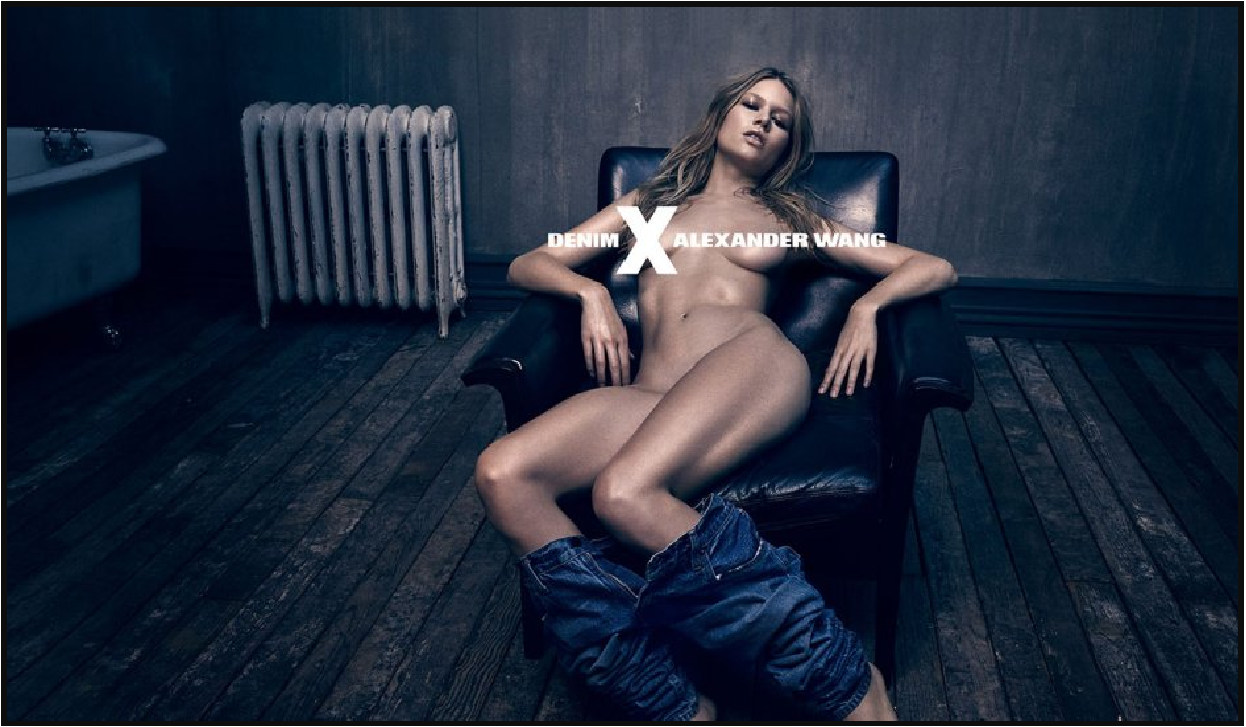Original Ad

Description of Original Ad
This advertisement represents designer Alexander Wang’s first Fall/Winter 2014 denim collection. The image is of model Anna Ewers sitting naked in a chair with her pants crumpled at the bottom of her ankles in what appears to be a bathroom. The image is problematic on a practical level because the goal is to sell jeans, however, the consumer cannot actually see what they look like as Ewers is not wearing them. The jeans are not the focal point of this image, but rather her bare torso and Wang’s name strategically placed over Ewers’ breasts. As Glieck (2011) discusses, living beings have an interwoven communication network filled with words, information and instructions that are being transmitted, received, coded, and decoded. As an audience member, I understand the story being communicated as Ewers either passed out before taking a bath, or she was left there after being assaulted. Because she is slouching and disengaged from eye contact, she appears vulnerable. The message I receive is that she is prey for sexual gratification. The instructions I decode are that if I buy these jeans, I can be sexy, look sexy, and have sex while semi-conscious. This ad promotes rape culture and perpetuates patriarchy as Ewers informs the consumer she is submissive through her body language. The image normalizes and glorifies sexual violence. The issue I will be addressing is the normalizing of violence against women in the fashion industry for capital gain. One is not just buying jeans, but buying into a lifestyle as Zizek (2011) explains. The consumer buys into expensive taste, style, and also sexual violence. The ad conveys the social acceptance of the hideousness of violence against women under the guise of high fashion.
Jammed Ad

Description of Jammed Ad
I wanted to communicate a transparent message about what is being advertised. I wrote “rape culture by designer corporations” to connect devaluing women for financial gain. Capitalism is indispensable compared to women in society, where objectification is acceptable so long as businesses thrive. The former creative director of Balenciaga and H&M collaborator explained he wanted to provoke conversation. Rape is tolerable because of the artistic expression argument in pursuit of revenue. Klein (2012) argues how shock value is used to facilitate the neoliberal economic model. By using shocking images of sexual violence at Ewers expense, Wang increases his profile and personal profit. Free markets and autonomy are values associated with neoliberalism. Using this lens, consumers can choose not to purchase jeans if they disagree with the image’s messaging. However, hypersexualizing women allows corporations to justify capitalist competition. I chose green to convey the message that despite her unconscious state, Wang pushes the customer to believe she is giving the ‘green light’ to engage in sexual activity. Green also connotes money. Because a high-profile designer and industry heavy weights are associated with this image, the ad validates that an unconscious naked body is fashionable and profitable, not sexually exploitative. As Bhandar and da Silva (2013) illustrate, feminism can be co-opted by neoliberalism as a capitalist venture. There is a fine line between empowerment and exploitation. While Ewers chose to work with Wang, working in the industry should not imply that being sexualized is admissible because it is a good business strategy. Decoding the ad solely from a neoliberal perspective by concentrating on Ewers choice to model ignores the structural forces in the construction of this image. Had Ewers refused to pose nude, she risked damaging her working relationship with Wang, threatened to be blacklisted in the industry, and be reprimanded by her agency. Based on her social location in respect to other players, she is not in a position of power. In this way, women are subordinated by the neoliberal model that sustains paternalism and violence against women. Females receive information that sexual violence is a nonissue when profit is involved. This harmful message is why we have a responsibility to be provocateurs to expose how corporate and political interests use the media as a tool for behaviour modification as Dery (2010) explains.
References
Dery, M. (2018, February 13). Books: Culture Jamming: Hacking, Slashing, and Sniping in the Empire of Signs. Retrieved from Mark Dery Web site: http://markdery.com/?page_id=154
Gleick, J. (2011, May). What Defines a Meme? Retrieved from Smithsonian Web site: https://www.smithsonianmag.com/arts-culture/what-defines-a-meme-1904778/?no-ist
Silva, B. B. (2013, October 21). White Feminist Fatigue Syndrome. Retrieved from Critical Legal Thinking Web site: http://criticallegalthinking.com/2013/10/21/white-feminist-fatigue-syndrome/
Think, B. (2013, April https://www.youtube.com/watch?v=sKTmwu3ynOY). Naomi Klein on Global Neoliberalism . United States of America.
Wikipedia. (2018, February 14). Alexander Wang. Retrieved from Wikipedia Web site: https://en.wikipedia.org/wiki/Alexander_Wang_(designer)
Wikipedia. (2018, February 13). Big Think. Retrieved from Wikipedia Web site: https://en.wikipedia.org/wiki/Big_Think
Zizek, S. (2011, November https://www.youtube.com/watch?v=GRvRm19UKdA). Ethics of Consumption – cultural capitalism.